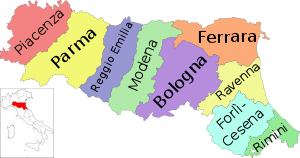Metropolitan City of Bologna
| Metropolitan City of Bologna | |
|---|---|
| Metropolitan City | |
|
Palazzo Malvezzi in Bologna, seat of the metropolitan city. | |
 Map highlighting the location of the province of Bologna in Italy | |
| Country |
|
| Region | Emilia-Romagna |
| Capital(s) | Bologna |
| Comuni | 60 |
| Government | |
| • Mayor | Virginio Merola |
| Area | |
| • Total | 3,702 km2 (1,429 sq mi) |
| Population (1 January 2016) | |
| • Total | 1,005,831 |
| • Density | 270/km2 (700/sq mi) |
| Time zone | CET (UTC+1) |
| • Summer (DST) | CEST (UTC+2) |
| Postal code | 40121/40141 (Bologna), 40010-40069 (other comuni) |
| Telephone prefix | 051, 0534, 0542 |
| Vehicle registration | BO |
| ISTAT | 037 |
| Website | Official website |
The Metropolitan City of Bologna (Italian: Città Metropolitana di Bologna) is a metropolitan city in the Emilia Romagna region, Italy. Its capital is the city of Bologna. Replacing the Province of Bologna, it was first created by the reform of local authorities (Law 142/1990) and then established by the Law 56/2014. It has been operative since January 1, 2015.
The Metropolitan City is headed by the Metropolitan Mayor (Sindaco metropolitano) and by the Metropolitan Council (Consiglio metropolitano).
History
Remains of Villanovan culture (early Iron Age) were discovered near Bologna by archaeologists in 1853.[1] The city was settled by the Etruscans and named Velzna, but was later renamed Felsina. In the 6th century BCE, Felsina was known for its markets and trade. It was invaded by Galic tribe the Boii in this period and helped increase the agricultural output of the region. The Romans decided to conquer the region in around 220 BCE and were successful by the 180s BCE; upon capturing Felsina, it was renamed Bononia. After Rome fell in 476 CE and the region suffered barbarian invasions, Bononia was made a fortress.[1]
The city was owned by Charlemagne but was given to the Holy See in 774. The Holy Roman Empire owned the city after this and it became known as Bologna, and became a commune in around 1114, although it desired independence. It joined the Lombard League in 1176 to defeat the forces of the Holy Roman Empire, and Frederick I, Holy Roman Emperor recognised its desire for independence and granted it some autonomy.[1] It joined the Second Lombard League to defeat Frederick II, Holy Roman Emperor in 1249. It became part of the Papal States in 1506 and later joined the Kingdom of Italy.[2]
The University of Bologna was founded in 1088 and was in advance of its times; its speciality was Roman and canon law, and it set standards in the way it was organised and the curriculum that were followed by other universities that sprang up elsewhere in Italy.[3]
Geography
The Metropolitan City of Bologna is part of the region of Emilia-Romagna in northwestern Italy. It is in the centre of the region and is bounded on the east by the Province of Ravenna, while the Province of Ferrara lies to the north and the Province of Modena lies to the west. To the south are the Metropolitan City of Florence, the Province of Prato and the Province of Pistoia, all in the region of Tuscany.
The metropolitan territory is largely flat, and stretches from the alluvial Po Plain into the Apennine Mountains; the highest point in the metropolitan city is the peak of Corno alle Scale in the commune of Lizzano in Belvedere, which is 1,945 metres (6,381 ft) above sea level.[4]
References
- 1 2 3 Roy Palmer Domenico (2002). The Regions of Italy: A Reference Guide to History and Culture. Greenwood Publishing Group. p. 80. ISBN 978-0-313-30733-1.
- ↑ Roy Palmer Domenico (2002). The Regions of Italy: A Reference Guide to History and Culture. Greenwood Publishing Group. p. 81. ISBN 978-0-313-30733-1.
- ↑ Christopher Kleinhenz (2004). Medieval Italy: An Encyclopedia. Routledge. p. 1107. ISBN 978-1-135-94880-1.
- ↑ The Times Comprehensive Atlas of the World (13 ed.). Times Books. 2011. p. 76. ISBN 9780007419135.
External links
- Official website (Italian)
Coordinates: 44°29′38″N 11°20′34″E / 44.4939°N 11.3428°E
